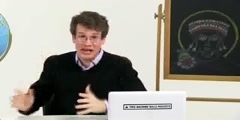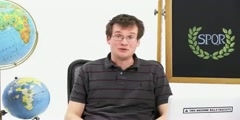Lec 10 - Accessing Afterlife: Tombs of Roman Aristocrats, Freedmen, and Slaves
"Lec 10 - Accessing Afterlife: Tombs of Roman Aristocrats, Freedmen, and Slaves" Roman Architecture (HSAR 252) Professor Kleiner explores sepulchral architecture in Rome commissioned by the emperor, aristocrats, successful professionals, and former slaves during the age of Augustus. Unlike most civic and residential buildings, tombs serve no practical purpose other than to commemorate the deceased and consequently assume a wide variety of personalized and remarkable forms. The lecture begins with the round Mausoleum of Augustus, based on Etruscan precedents and intended to house the remains of Augustus and the new Julio-Claudian dynasty. Professor Kleiner also highlights two of Rome's most unusual funerary structures: the pyramidal Tomb of Gaius Cestius, an aristocrat related to Marcus Agrippa, and the trapezoidal Tomb of Marcus Vergilius Eurysaces, probably a former slave who made his fortune overseeing the baking and public distribution of bread for the Roman army. Professor Kleiner concludes the lecture with a brief discussion of tombs for those with more modest means, including extensive subterranean columbaria. She also turns briefly to the domed thermal baths at Baia, part of an ancient spa and a sign of where concrete construction would take the future of Roman architecture. 00:00 - Chapter 1. Augustus Family Mausoleum 11:04 - Chapter 2. Etruscan Antecedents of the Mausoleum of Augustus 19:13 - Chapter 3. The Tomb of Caecilia Metella on the Via Appia 28:55 - Chapter 4. The Pyramidal Tomb of Gaius Cestius 41:33 - Chapter 5. The Tomb of the Baker Eurysaces and His Wife Atistia 50:30 - Chapter 6. Atistias Breadbasket and Eurysaces Achievements 01:00:16 - Chapter 7. Tombs for Those of Modest Means and the Future of Concrete Architecture Complete course materials are available at the Open Yale Courses website: http://open.yale.edu/courses This course was recorded in Spring 2009.
Video is embedded from external source so embedding is not available.
Video is embedded from external source so download is not available.
Channels: Others
Tags: Lec 10 - Accessing Afterlife: Tombs of Roman Aristocrats, Freedmen, and Slaves
Uploaded by: yalearchitecture ( Send Message ) on 12-09-2012.
Duration: 71m 57s
Here is the next lecture for this course
Lec 1 - Introduction to Roman Architecture
42:31 | 3560 viewsLec 16 - The Roman Way of Life and Death ...
01:16:09 | 4052 viewsLec 19 - Baroque Extravaganzas: Rock Tomb ...
01:12:55 | 2792 viewsLec Last - The Afterlife of the New Testa ...
47:41 | 2919 viewsOpening a Roman Coffin
00:00 | 6042 viewsLec 3 - Technology and Revolution in Roma ...
01:10:49 | 2832 viewsLec 6 - Habitats at Herculaneum and Early ...
01:12:44 | 2847 viewsLec 18 - Hometown Boy: Honoring an Empero ...
01:12:59 | 3259 viewsLec 20 - Roman Wine in Greek Bottles: The ...
01:16:03 | 3152 viewsLec 4 - The Christian Roman Empire
47:56 | 3248 viewsLec 3 - The Greco-Roman World
48:42 | 3027 viewsLec 6 -Transformation of the Roman Empire
49:22 | 3494 viewsTracking Souls to the Afterlife Through t ...
02:38 | 3766 viewsReason Behind The Fall of Roman Empire
12:44 | 3247 viewsHistory of The Roman Empire
12:25 | 3641 viewsNo content is added to this lecture.
This video is a part of a lecture series from of Yale
Lecture list for this course
Lec 1 - Introduction to Roman Architecture
Lec 2 - It Takes a City: The Founding of Rome and the Beginnings of Urbanism in Italy
Lec 3 - Technology and Revolution in Roman Architecture
Lec 4 - Civic Life Interrupted: Nightmare and Destiny on August 24, A.D. 79
Lec 5 - Lifestyles of the Rich and Famous: Houses and Villas at Pompeii
Lec 6 - Habitats at Herculaneum and Early Roman Interior Decoration
Lec 7 - Gilding the Lily: Painting Palaces and Villas in the First Century A.D.
Lec 8 - Exploring Special Subjects on Pompeian Walls
Lec 9 - From Brick to Marble: Augustus Assembles Rome
Lecture 11 - Notorious Nero and His Amazing Architectural Legacy
Lec 12 - The Creation of an Icon: The Colosseum and Contemporary Architecture in Rome
Lec 13 - The Prince and the Palace: Human Made Divine on the Palatine Hill
Lec 14 - The Mother of All Forums: Civic Architecture in Rome under Trajan
Lec 15 - Rome and a Villa: Hadrian's Pantheon and Tivoli Retreat
Lec 16 - The Roman Way of Life and Death at Ostia, the Port of Rome
Lec 18 - Hometown Boy: Honoring an Emperor's Roots in Roman North Africa
Lec 19 - Baroque Extravaganzas: Rock Tombs, Fountains, and Sanctuaries in Jordan, Lebanon, and Libya
















